Integrated agriculture-aquaculture farming systems in Vietnam: The status quo and future perspectives
The integrated agriculture-aquaculture (IAA) farming system has
been considered a form of diversified agriculture applied in Asia. In
this paper, several IAA farming systems practiced in Vietnam are
described, and their impacts are also reviewed. It is speculated that in
developing countries like Vietnam, the IAA farming system should
be targeted for support as a sustainable food safety model and a form
of ecosystem-based technology to reduce environmental impacts,
adapt to climate change, help avoid risks from market fluctuation, and
increase incomes in comparison with monoculture farming.
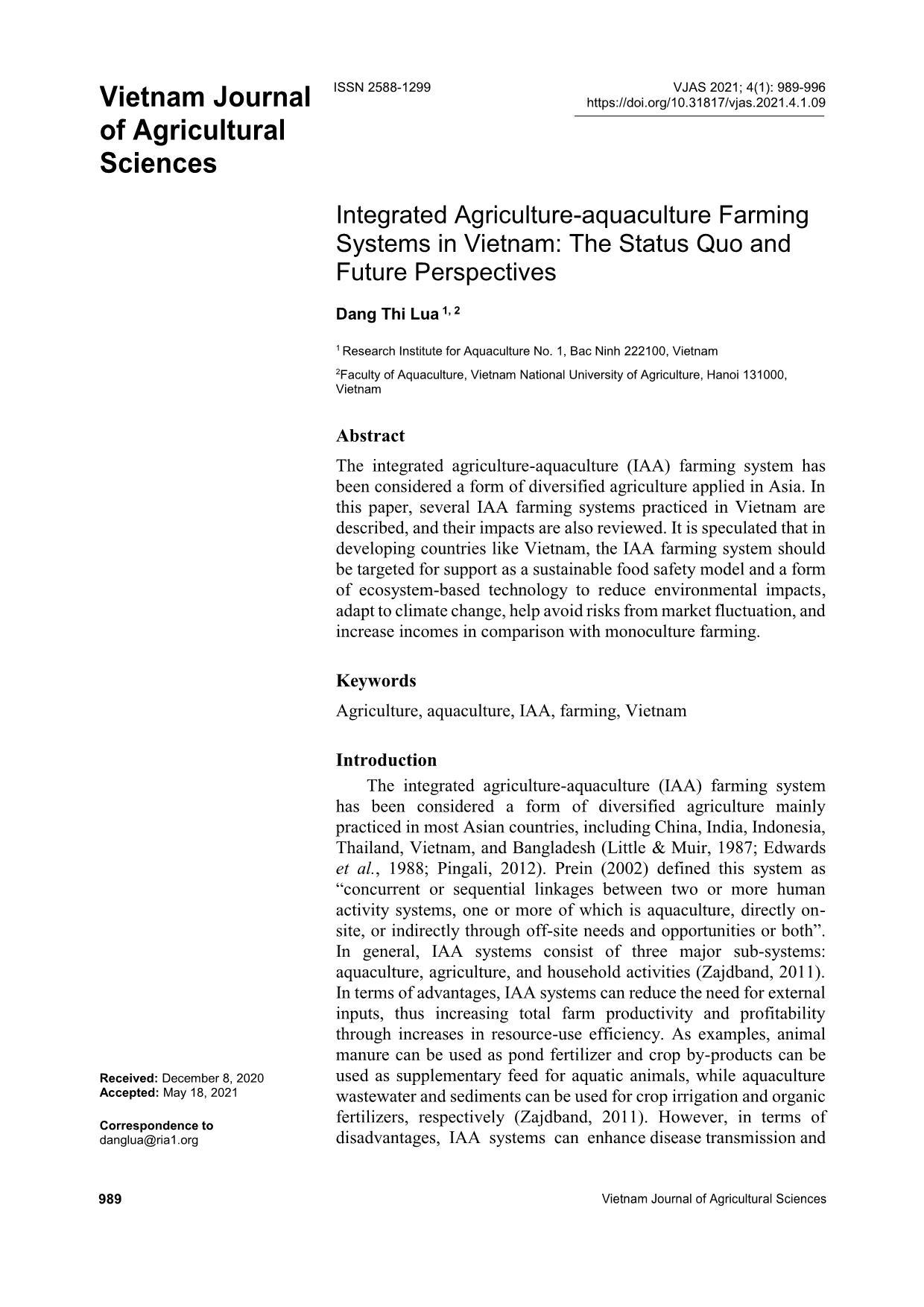
Trang 1

Trang 2
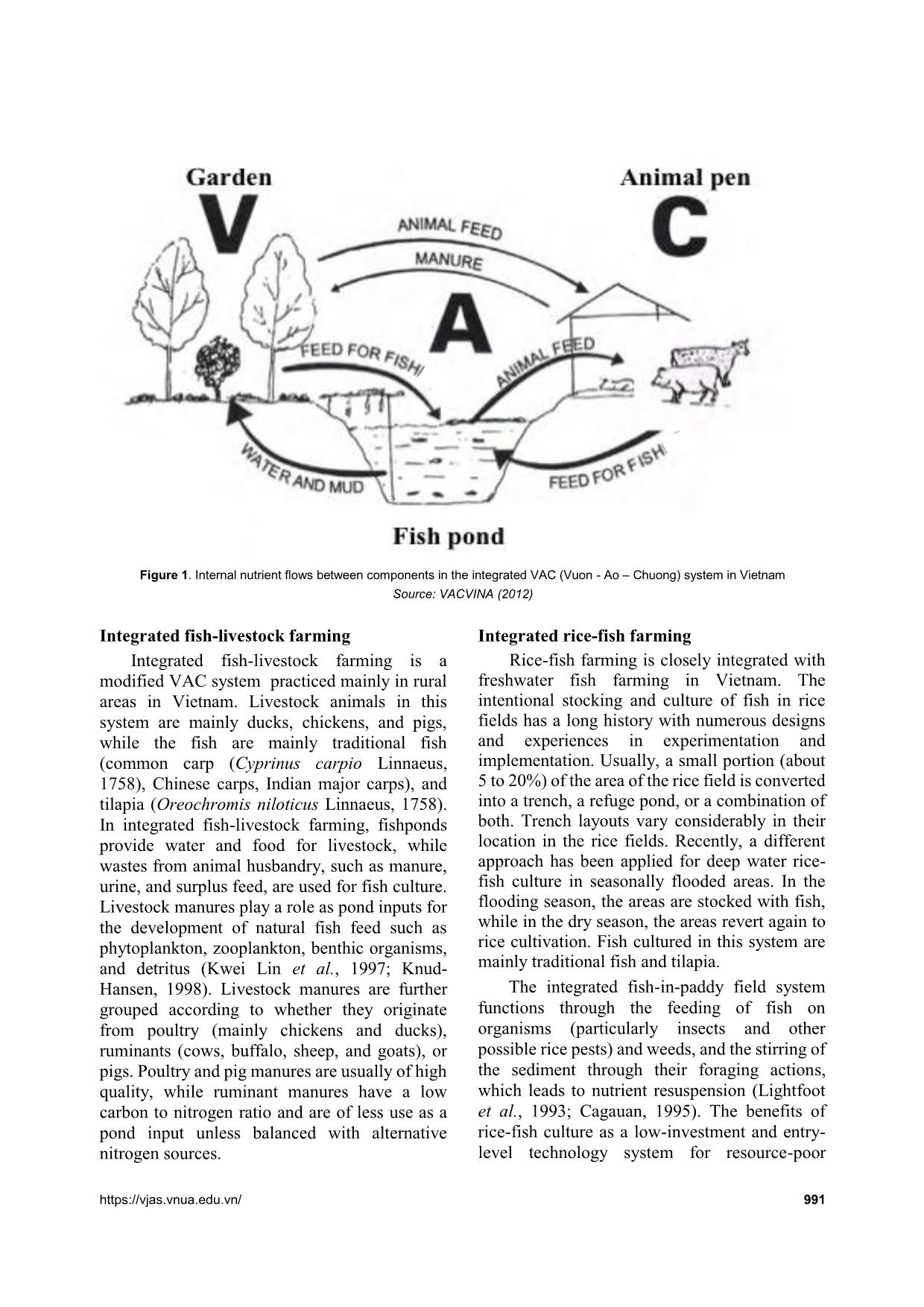
Trang 3
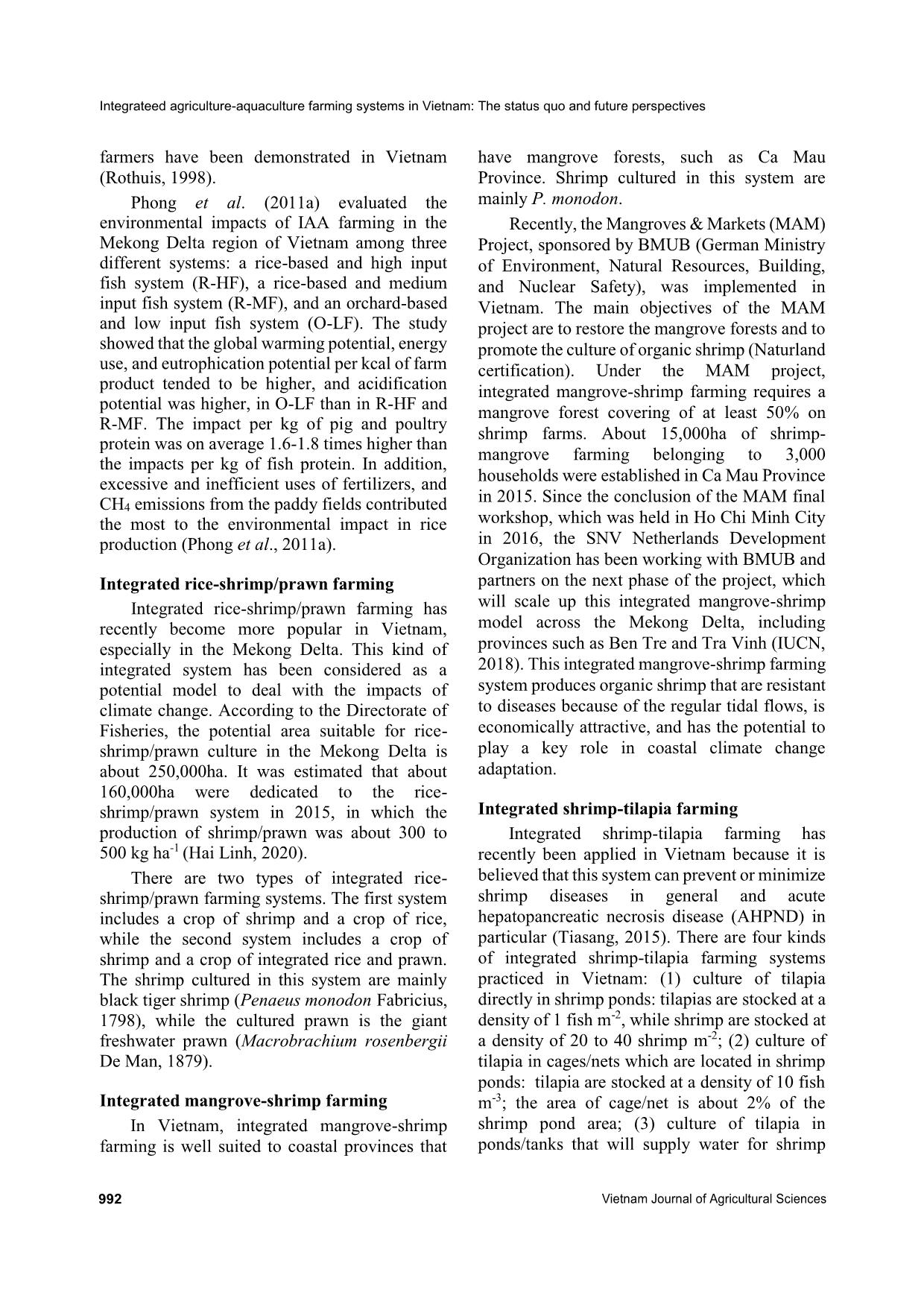
Trang 4
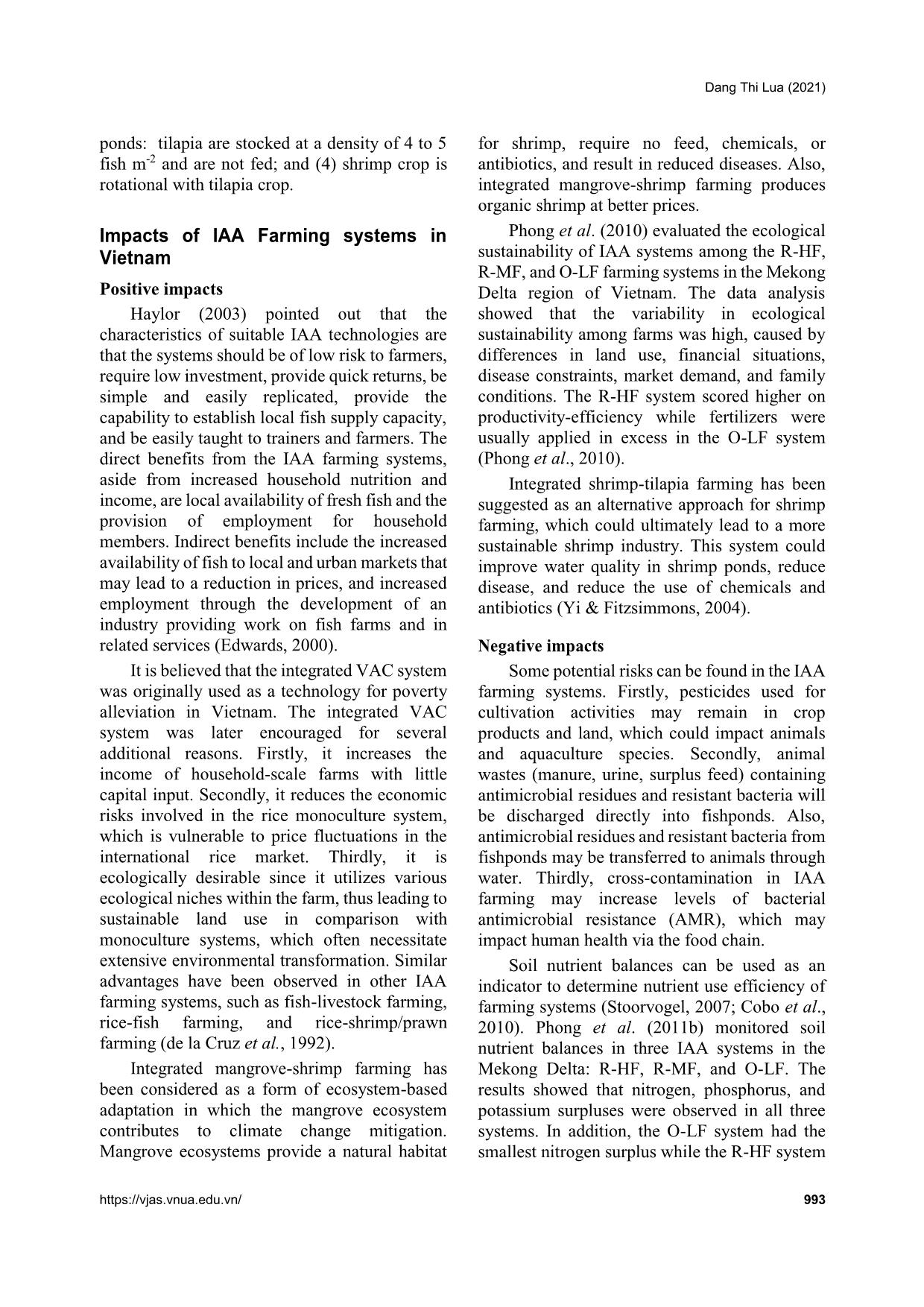
Trang 5
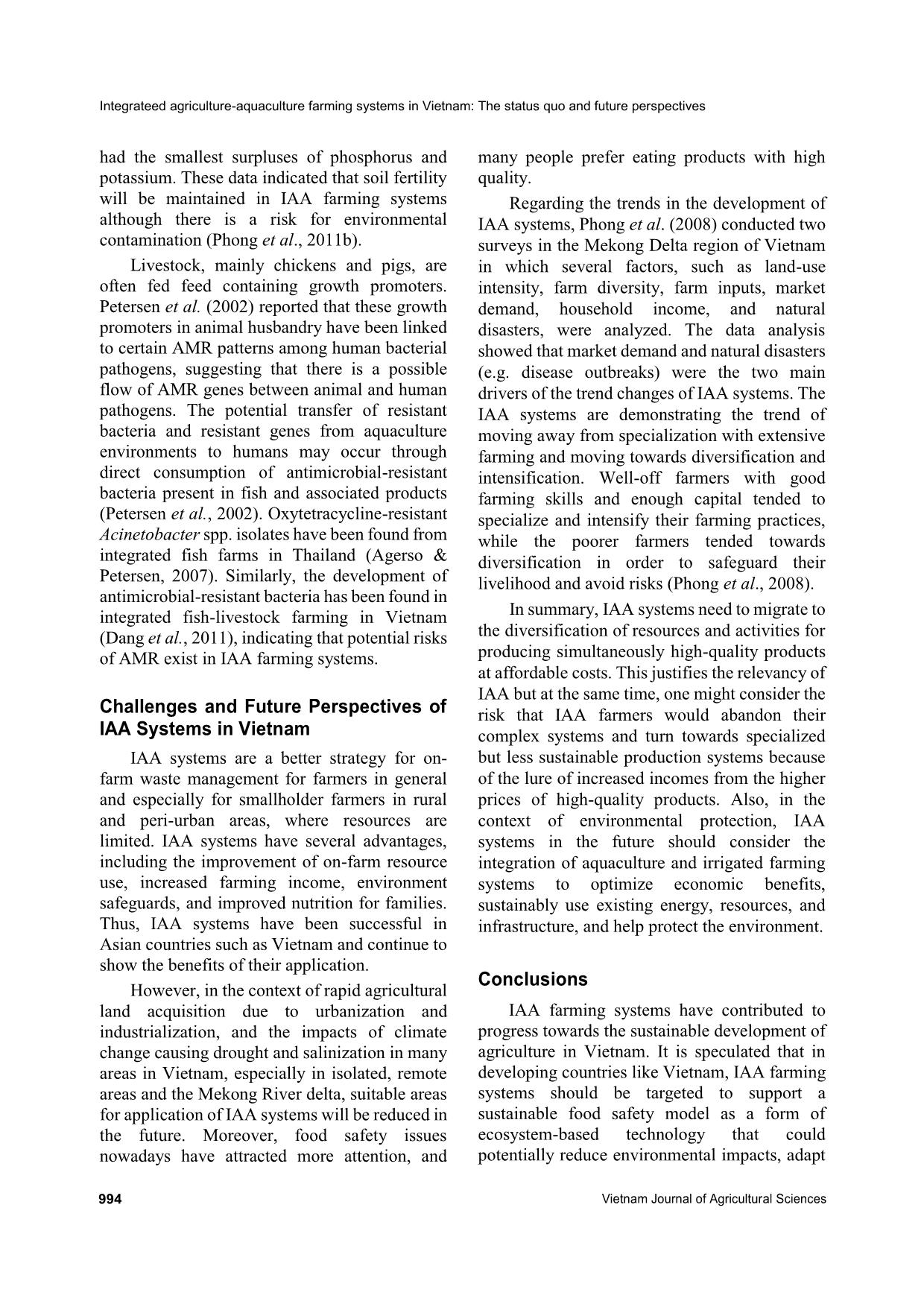
Trang 6

Trang 7
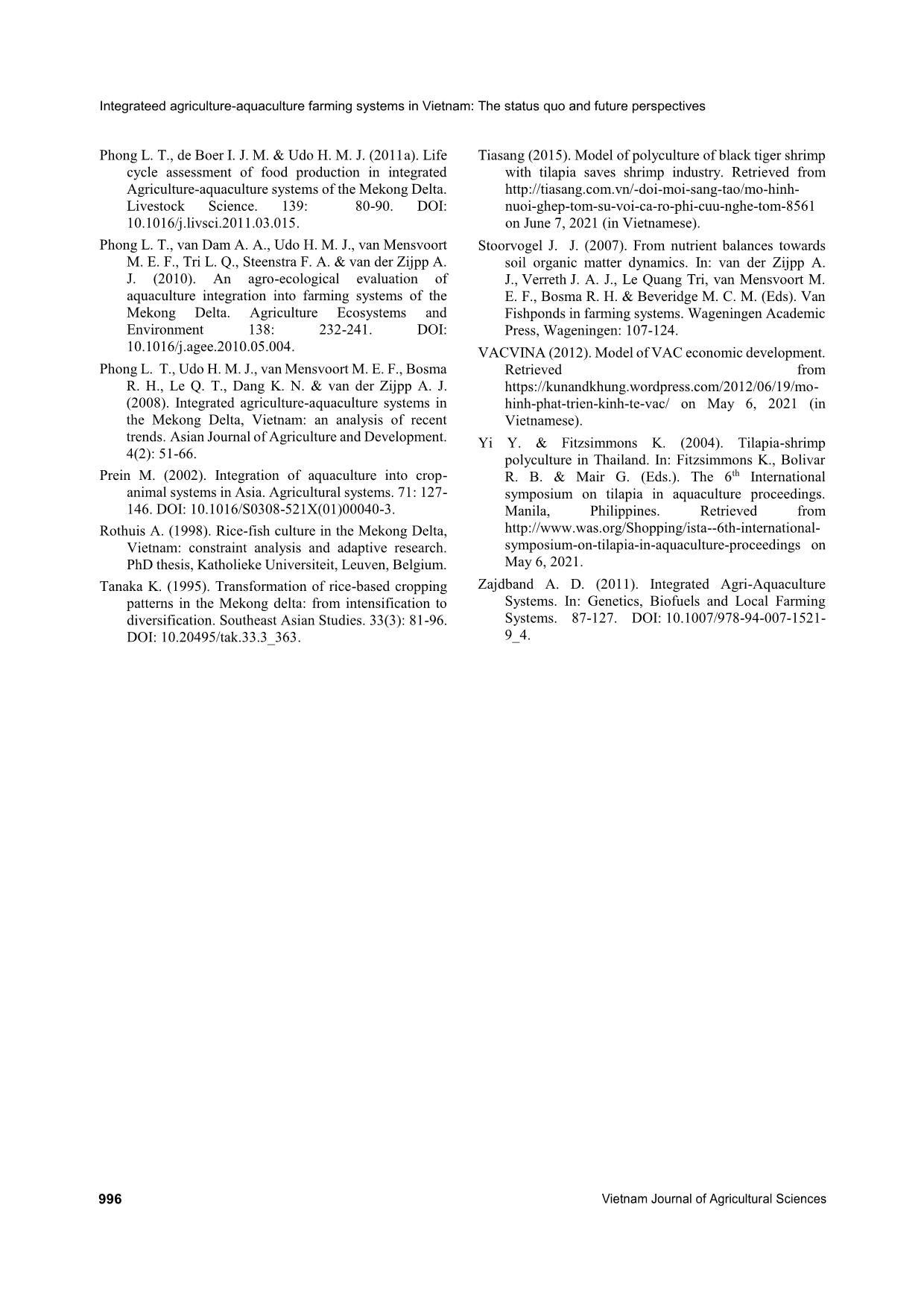
Trang 8
Bạn đang xem tài liệu "Integrated agriculture-aquaculture farming systems in Vietnam: The status quo and future perspectives", để tải tài liệu gốc về máy hãy click vào nút Download ở trên
Tóm tắt nội dung tài liệu: Integrated agriculture-aquaculture farming systems in Vietnam: The status quo and future perspectives
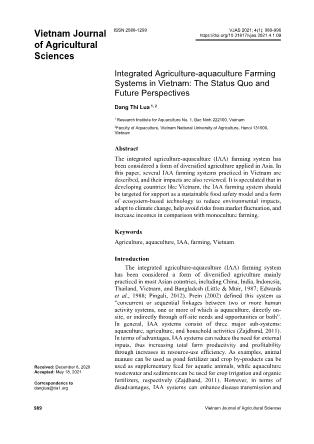
r IAA farming systems, such as fish-livestock farming, rice-fish farming, and rice-shrimp/prawn farming (de la Cruz et al., 1992). Integrated mangrove-shrimp farming has been considered as a form of ecosystem-based adaptation in which the mangrove ecosystem contributes to climate change mitigation. Mangrove ecosystems provide a natural habitat for shrimp, require no feed, chemicals, or antibiotics, and result in reduced diseases. Also, integrated mangrove-shrimp farming produces organic shrimp at better prices. Phong et al. (2010) evaluated the ecological sustainability of IAA systems among the R-HF, R-MF, and O-LF farming systems in the Mekong Delta region of Vietnam. The data analysis showed that the variability in ecological sustainability among farms was high, caused by differences in land use, financial situations, disease constraints, market demand, and family conditions. The R-HF system scored higher on productivity-efficiency while fertilizers were usually applied in excess in the O-LF system (Phong et al., 2010). Integrated shrimp-tilapia farming has been suggested as an alternative approach for shrimp farming, which could ultimately lead to a more sustainable shrimp industry. This system could improve water quality in shrimp ponds, reduce disease, and reduce the use of chemicals and antibiotics (Yi & Fitzsimmons, 2004). Negative impacts Some potential risks can be found in the IAA farming systems. Firstly, pesticides used for cultivation activities may remain in crop products and land, which could impact animals and aquaculture species. Secondly, animal wastes (manure, urine, surplus feed) containing antimicrobial residues and resistant bacteria will be discharged directly into fishponds. Also, antimicrobial residues and resistant bacteria from fishponds may be transferred to animals through water. Thirdly, cross-contamination in IAA farming may increase levels of bacterial antimicrobial resistance (AMR), which may impact human health via the food chain. Soil nutrient balances can be used as an indicator to determine nutrient use efficiency of farming systems (Stoorvogel, 2007; Cobo et al., 2010). Phong et al. (2011b) monitored soil nutrient balances in three IAA systems in the Mekong Delta: R-HF, R-MF, and O-LF. The results showed that nitrogen, phosphorus, and potassium surpluses were observed in all three systems. In addition, the O-LF system had the smallest nitrogen surplus while the R-HF system Integrateed agriculture-aquaculture farming systems in Vietnam: The status quo and future perspectives 994 Vietnam Journal of Agricultural Sciences had the smallest surpluses of phosphorus and potassium. These data indicated that soil fertility will be maintained in IAA farming systems although there is a risk for environmental contamination (Phong et al., 2011b). Livestock, mainly chickens and pigs, are often fed feed containing growth promoters. Petersen et al. (2002) reported that these growth promoters in animal husbandry have been linked to certain AMR patterns among human bacterial pathogens, suggesting that there is a possible flow of AMR genes between animal and human pathogens. The potential transfer of resistant bacteria and resistant genes from aquaculture environments to humans may occur through direct consumption of antimicrobial-resistant bacteria present in fish and associated products (Petersen et al., 2002). Oxytetracycline-resistant Acinetobacter spp. isolates have been found from integrated fish farms in Thailand (Agerso & Petersen, 2007). Similarly, the development of antimicrobial-resistant bacteria has been found in integrated fish-livestock farming in Vietnam (Dang et al., 2011), indicating that potential risks of AMR exist in IAA farming systems. Challenges and Future Perspectives of IAA Systems in Vietnam IAA systems are a better strategy for on- farm waste management for farmers in general and especially for smallholder farmers in rural and peri-urban areas, where resources are limited. IAA systems have several advantages, including the improvement of on-farm resource use, increased farming income, environment safeguards, and improved nutrition for families. Thus, IAA systems have been successful in Asian countries such as Vietnam and continue to show the benefits of their application. However, in the context of rapid agricultural land acquisition due to urbanization and industrialization, and the impacts of climate change causing drought and salinization in many areas in Vietnam, especially in isolated, remote areas and the Mekong River delta, suitable areas for application of IAA systems will be reduced in the future. Moreover, food safety issues nowadays have attracted more attention, and many people prefer eating products with high quality. Regarding the trends in the development of IAA systems, Phong et al. (2008) conducted two surveys in the Mekong Delta region of Vietnam in which several factors, such as land-use intensity, farm diversity, farm inputs, market demand, household income, and natural disasters, were analyzed. The data analysis showed that market demand and natural disasters (e.g. disease outbreaks) were the two main drivers of the trend changes of IAA systems. The IAA systems are demonstrating the trend of moving away from specialization with extensive farming and moving towards diversification and intensification. Well-off farmers with good farming skills and enough capital tended to specialize and intensify their farming practices, while the poorer farmers tended towards diversification in order to safeguard their livelihood and avoid risks (Phong et al., 2008). In summary, IAA systems need to migrate to the diversification of resources and activities for producing simultaneously high-quality products at affordable costs. This justifies the relevancy of IAA but at the same time, one might consider the risk that IAA farmers would abandon their complex systems and turn towards specialized but less sustainable production systems because of the lure of increased incomes from the higher prices of high-quality products. Also, in the context of environmental protection, IAA systems in the future should consider the integration of aquaculture and irrigated farming systems to optimize economic benefits, sustainably use existing energy, resources, and infrastructure, and help protect the environment. Conclusions IAA farming systems have contributed to progress towards the sustainable development of agriculture in Vietnam. It is speculated that in developing countries like Vietnam, IAA farming systems should be targeted to support a sustainable food safety model as a form of ecosystem-based technology that could potentially reduce environmental impacts, adapt Dang Thi Lua (2021) https://vjas.vnua.edu.vn/ 995 to climate change, and increase incomes in comparison with monoculture farming. References Agerso Y. & Petersen A. (2007). The tetracycline resistance determinant Tet 39 and the sulphonamide resistance gene sulII are common among resistant Acinetobacter spp. isolated from integrated fish farms in Thailand. Journal of antimicrobial chemotherapy. 59(1): 23-27. DOI: 10.1093/jac/dkl419. Cagauan A. G. (1995). Overview of the potential roles of pisciculture on pest and disease control and nutrient management in rice fields. In: Symoens J. J. & Micha J. C. (Eds.). The management of integrated freshwater agro-pisciculture Ecosystems in tropical areas: 203- 244. Proceedings of an International Seminar, May 16- 19, 1994, Brussels, Belgium. Technical Centre for Agricultural and Rural Cooperation (CTA), Wageningen, Holland and the Belgian Royal Academy of Overseas Sciences (ARSOM), Brussels, Belgium. Cobo J. G., Dercon G. & Cadisch G. (2010). Nutrient balances in African land use systems across different spatial scales: a review of approaches, challenges and progress. Agriculture, Ecosystems and Environment. 136: 1-15. Dang T. T. S., Petersen A., Truong D. V., Chu H. T. T. & Dalsgaard A. (2011). Impact of medicated feed on the development of antimicrobial resistance in bacteria at integrated pig-fish farms in Vietnam. Applied and Environmental Microbiology. 77(13): 4494-4498. DOI: 10.1128/AEM.02975-10. De Silva S. S., Nguyen T. T. T., Turchini G. M., Amarasinghe U. S. & Abery N. W. (2009). Alien species in aquaculture and biodiversity: a paradox in food production. AMBIO A Journal of the human environment. 38(1): 24–28. DOI: 10.1579/0044-7447- 38.1.24. dela Cruz C. R., Lightfoot C., Costa-Pierce B. A., Carangal V. R. & Bimbao M. P. (1992). Rice–fish research and development in Asia. ICLARM Conference Proceedings. 24. ICLARM, Manila, Philippines. 457. Do Van Hoa et al. (2020). Survey on economic potential of VAC system in some northern mountainous provinces: More effort is needed. Retrieved from https://kinhtenongthon.vn/khao-sat-kinh-te-vac-cua- ho-gia-dinh-tai-mot-so-tinh-mien-nui-phia-bac-can- no-luc-nhieu-hon-post38462.html on May 6, 2021 (in Vietnamese). Edwards P. (2000). Aquaculture, poverty impacts and livelihoods. ODI Natural Resource Perspectives 56. ODI, London, United Kingdom. Edwards P., Pullin R. S. V. & Gartner J. A. (1988). Research and education for the development of integrated crop-livestock-fish farming systems in the tropics. ICLARM Studies and Reviews 16, International Center for Living Aquatic Resources Management, Manila, Philippines. 53. Hai Linh (2020). Prospects of rice cum shrimp model. Journal of Vietnam Fisheries. Retrieved from https://thuysanvietnam.com.vn/trien-vong-mo-hinh- tom-lua/ on May 6, 2021 (in Vietnamese). Haylor G. (2003). Aquatic resources management for sustainable livelihoods of poor people: proceedings of DFID-ARM e-mail conference, June 2000, Bangkok, Thailand. Support to regional Aquatic Resources Management (STREAM). Retrieved from on May 6, 2021. IUCN (2018). Mangroves & markets final workshop: results and lessons learned. Retrieved from https://www.iucn.org/content/mangroves-markets- final-workshop-results-and-lessons-learned on May 18, 2018. Knud-Hansen C. F. (1998). Pond fertilization: ecological approach and practical applications. Pond Dynamics/Aquaculture Collaborative Research Support Program. Oregon State University. 125. Kwei Lin C., Teichert-Coddington D. R., Green B. W. & Veverica K. L. (1997). Fertilization regimes. In: Egna H. S. & Boyd C. E. (Eds.). Dynamics of Pond Aquaculture. CRC Press, Boca Raton, Florida, USA. 73-107. Little D. & Muir J. (1987). A guide to integrated warm water aquaculture. Institute of Aquaculture. University of Stirling, Stirling, Scotland. 238. Lightfoot C., Roger P. A., Cagauan A. G. & Dela Cruz C. R. (1993). Preliminary steady-state models of a wetland rice field ecosystem with and without fish. In: Christensen V. & Pauly D. (Eds.). Trophic models of aquatic ecosystems. 56-64. ICLARM Conference Proceedings 26, Manila, Philippines. Misui H. & Horiuchi H. (2006). Classification of VAC farming systems: A case study of Bac Son commune in the Red River delta, Vietnam. Journal of agricultural development studies (Japan). 17(2) :1-6. Petersen A., Andersen J. S., Kaewmak T., Somsiri T. & Dalsgaard A. (2002). Impact of integrated fish farming on antimicrobial resistance in a pond environment. Applied and environmental microbiology. 68(12): 6036-6042. DOI: 10.1128/aem.68.12.6036- 6042.2002. Pingali P. L. (2012). Green Revolution: Impacts, limits, and the path ahead. Proceedings of the National Academy of Sciences of the United States of America. 109(31): 12302-12308. DOI: 10.1073/pnas.0912953109. Phong L. T., Stoorvogel J. J. M., van Mensvoort E. F. & Udo H. M. J. (2011b). Modeling the soil nutrient balance of integrated agriculture-aquaculture systems in the Mekong Delta, Vietnam. Nutrient Cycling Agroecosystems. 90: 33-49. DOI: 10.1007/s10705- 010-9410-4. Integrateed agriculture-aquaculture farming systems in Vietnam: The status quo and future perspectives 996 Vietnam Journal of Agricultural Sciences Phong L. T., de Boer I. J. M. & Udo H. M. J. (2011a). Life cycle assessment of food production in integrated Agriculture-aquaculture systems of the Mekong Delta. Livestock Science. 139: 80-90. DOI: 10.1016/j.livsci.2011.03.015. Phong L. T., van Dam A. A., Udo H. M. J., van Mensvoort M. E. F., Tri L. Q., Steenstra F. A. & van der Zijpp A. J. (2010). An agro-ecological evaluation of aquaculture integration into farming systems of the Mekong Delta. Agriculture Ecosystems and Environment 138: 232-241. DOI: 10.1016/j.agee.2010.05.004. Phong L. T., Udo H. M. J., van Mensvoort M. E. F., Bosma R. H., Le Q. T., Dang K. N. & van der Zijpp A. J. (2008). Integrated agriculture-aquaculture systems in the Mekong Delta, Vietnam: an analysis of recent trends. Asian Journal of Agriculture and Development. 4(2): 51-66. Prein M. (2002). Integration of aquaculture into crop- animal systems in Asia. Agricultural systems. 71: 127- 146. DOI: 10.1016/S0308-521X(01)00040-3. Rothuis A. (1998). Rice-fish culture in the Mekong Delta, Vietnam: constraint analysis and adaptive research. PhD thesis, Katholieke Universiteit, Leuven, Belgium. Tanaka K. (1995). Transformation of rice-based cropping patterns in the Mekong delta: from intensification to diversification. Southeast Asian Studies. 33(3): 81-96. DOI: 10.20495/tak.33.3_363. Tiasang (2015). Model of polyculture of black tiger shrimp with tilapia saves shrimp industry. Retrieved from nuoi-ghep-tom-su-voi-ca-ro-phi-cuu-nghe-tom-8561 on June 7, 2021 (in Vietnamese). Stoorvogel J. J. (2007). From nutrient balances towards soil organic matter dynamics. In: van der Zijpp A. J., Verreth J. A. J., Le Quang Tri, van Mensvoort M. E. F., Bosma R. H. & Beveridge M. C. M. (Eds). Van Fishponds in farming systems. Wageningen Academic Press, Wageningen: 107-124. VACVINA (2012). Model of VAC economic development. Retrieved from https://kunandkhung.wordpress.com/2012/06/19/mo- hinh-phat-trien-kinh-te-vac/ on May 6, 2021 (in Vietnamese). Yi Y. & Fitzsimmons K. (2004). Tilapia-shrimp polyculture in Thailand. In: Fitzsimmons K., Bolivar R. B. & Mair G. (Eds.). The 6th International symposium on tilapia in aquaculture proceedings. Manila, Philippines. Retrieved from symposium-on-tilapia-in-aquaculture-proceedings on May 6, 2021. Zajdband A. D. (2011). Integrated Agri-Aquaculture Systems. In: Genetics, Biofuels and Local Farming Systems. 87-127. DOI: 10.1007/978-94-007-1521- 9_4.
File đính kèm:
 integrated_agriculture_aquaculture_farming_systems_in_vietna.pdf
integrated_agriculture_aquaculture_farming_systems_in_vietna.pdf

